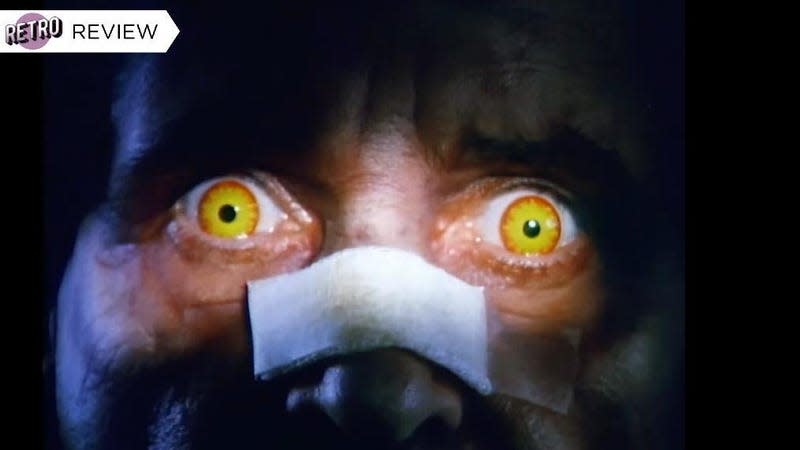The Exorcist III Is Its Own Wonderfully Unsettling Beast

- Oops!Something went wrong.Please try again later.
For many horror fans, much of their thinking about The Exorcist III is tied into That One Scene. It may be the scariest movie scene ever, and that’s saying a lot for a movie that’s the second sequel to what many call the scariest movie ever. But it’s not a meaningless “gotcha” moment; by the time The Exorcist III gets there, it’s laid the groundwork for the viewer to understand, if not anticipate, that the unimaginable can happen to its characters.
Released in 1990, The Exorcist III was written and directed by William Peter Blatty, who won an Oscar for adapting his 1971 novel into the screenplay for William Friedkin’s 1973 Exorcist. For part three, he adapted his 1983 sequel novel Legion (we will acknowledge The Exorcist II: The Heretic by noting it has its own io9 retro review, and leave it at that); in 2016, a director’s cut version was released, thankfully ahead of Blatty’s passing in 2017. But no matter which version you dig into, and no matter if your interest in The Exorcist III was first piqued by talk of That One Scene or the memes that emerged after last year’s Dahmer - Monster: The Jeffrey Dahmer Story, it remains a triumphant horror sequel. It’s not a retread of The Exorcist—which The Exorcist: Believer, out October 6, looks like it could be—but it might be just as disturbing. It might be more disturbing.
Read more
The Creator is next-level sci-fi. So why isn't it being promoted that way?
‘All Of Sony Systems’ Allegedly Hacked By New Ransomware Group
You can stick a fork in these NFL teams, because they are done
Rick And Morty's season 7 trailer hints at the show's new voice star
If it were just a crime drama with the added attraction of carrying over plot elements from one of the best-known horror movies ever, The Exorcist III would be an entertaining and worthy successor. But it has its own doom-laden energy that feels more akin to Friedkin’s 1970s release than any of the jumpy thrillers that became a 1990s trademark. Through carefully off-putting editing and camerawork, and slippery characters in the supporting cast (especially Nancy Fish as Nurse Allerton), The Exorcist III warns that the viewer has to pay close attention; the demonic forces poking into the lives of Kinderman and company mean that we can’t always trust what we’re seeing onscreen. There are surreal dreams that bleed into the movie’s reality, and even the things that happen when everyone’s awake tend to drift into the unbelievable. The world of The Exorcist III is a tainted one, with dark forces scheming to settle unfinished business—but, helped in great part by Scott’s performance as the blustery but morally airtight Kinderman—it somehow doesn’t feel like a world drained of all hope.
It is, however, stuffed with operatic horrors that almost take it over the top so many times. The Exorcist III is saved from being a splatterfest by deploying restraint (the Gemini’s mutilated victims are, for the most part, kept beneath blood-spotted sheets), saving the most dramatic juice for, well, That One Scene. The build-up is agonizing—if you know it’s coming, you’re just waiting and waiting; if you don’t know it’s coming, prepare for the jump scare of your life—and lasts a generous five to 10 seconds at most. The killer’s favorite weapon, hefty shears that can sever a human head from its body in one chop, are almost comically freakish; they’re something Jason Voorhees might keep in his tool belt. But in the context of The Exorcist III, they perfectly establish a sense of mounting dread just thinking about how the killer is using them, so that by the time you see them in action, the payoff is perfection.
The Exorcist III is widely available to stream on various platforms, including Prime Video, Shudder, and Peacock.
Want more io9 news? Check out when to expect the latest Marvel, Star Wars, and Star Trek releases, what’s next for the DC Universe on film and TV, and everything you need to know about the future of Doctor Who.
More from Gizmodo
Pennsylvania Cop Who Committed Ex-Girlfriend to Mental Facility Charged With Abuse of Power
Starfield Gets Another Tiny Update As Players Wait For The Big One
Is Star Wars trying to ditch its most hilariously inappropriate name?
Sign up for Gizmodo's Newsletter. For the latest news, Facebook, Twitter and Instagram.

